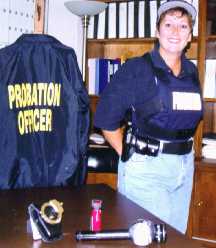It wasn’t all that long ago, that when probation officers
were hired, they were given an ink pen and a caseload of clients and were told to go do
their job. Safety equipment was unheard of and really wasn’t needed.
Carla Bass, judicial district manager for District 8-A, said when she was first hired
as a probation officer back in 1979, she spent most of her time acting as a counselor to
offenders, most of whom were alcohol offenders. She would help them find treatment and
counsel them on ways to improve their education.
"When I started, there wasn’t an officer in the state who was firearms
certified," she said. "We just didn’t need to be."

Trish Phelps Crowe displays some of the standard safety
equipment now approved for officers in the field. |
But over the past few years, times have really
changed. Offenders have become more violent, and with structured sentencing, probation and
parole officers are now supervising offenders who would have once been sent to prison.
Considering the changing nature of society and the offender population, management within
the Division of Community Corrections decided it was time to take some steps to ensure the
safety of the staff and the officers out in the field. So in November of 1996, an
Officer Safety Task Force was formed, under the direction of DCC Director Robert Guy, to
come up with recommendations for the implementation of policies, practices and training
designed to enhance the safety of officers and staff during the performance of their
duties. The task force was made up of 15 individuals representing every job position in
DCC.
Within a year, the task force members developed a new Use of Force model to provide
officers with several non-violent alternatives to use when dealing with offenders and came
up with a list of specific recommendations for improving office security and providing
officers and staff with proper equipment, clothing and training. This list was presented
to the Secretary of Correction for approval, and in May of 1998, an official Officer
Safety Package was approved based on many of the task force’s recommendations. |
As part of the Officer Safety Package, a list of standard equipment was approved
for all officers and staff along with security lockers for storage of the equipment. Now
all officers in the field receive body armor and identifiable caps and jackets as part of
their standard equipment. Kevin Wallace, DCC training coordinator and a member of the task
force, said the members believed that proper clothing plays a big part in the safety of
the officers.
"Having hats and jackets that say probation officer was very important to
us," he said. "As our officers are out in the field more, it is important for
the public to know who we are and, more importantly, for law enforcement to know who we
are. If we are out in the field carrying a weapon while checking up on an offender in a
dangerous neighborhood, it’s important that law enforcement know that we are
probation officers."
In addition to proper clothing, all officers in the field are now also provided
with some sort of communications equipment whether it be a radio or cellular phone.
"Prior to this, some probation officers would go out into the field without
any form of hand-held communication," Wallace said. "So we thought one of the
most important things we could do is to put a cellular phone or radio in the hands of all
the probation officers in the field, so if they get in a jam, they can call for
help."
Other safety measures which were approved include providing officers with OC
Pepper Spray and the appropriate training and revising the firearms policy. Now instead of
just surveillance officers, intermediate officers, intensive officers and chief probation
and parole officers working in the field are also approved to carry a firearm in the
performance of their duties.
"Probation officers are not law enforcement officers, but they do have the
power of arrest. Therefore, we thought it was important that probation officers be issued
a firearm and be trained in its use," Wallace said.
Although proper equipment is a big part of officer safety, Wallace said it is
just one small piece of the puzzle – he said training is just as important as
equipment. As a result, the Division’s mandatory in-service training schedule has
been revised to include more training in the areas of safety, and for the first time,
office assistants will also be included in certain training classes, covering such areas
as office safety, diffusing aggressive behavior and critical incident training.
Wallace said although a lot has been accomplished over the past few years in the
area of officer safety, he still feels that a lot more can still be done.
"Five years ago, we didn’t have anything in place in the area of
safety except for a few officers carrying firearms," he said. "It all goes back
to you have to crawl before you can walk. When we first started looking at the issue of
safety, we were crawling. Now I think we are walking. But we are not just going to sit
back now and say this is all we need to provide. As society changes, we will continue to
have to make changes to survive structured sentencing and what’s around the corner in
the year 2000." u
